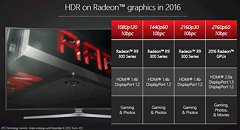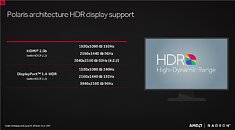- Joined
- Oct 9, 2007
- Messages
- 47,166 (7.56/day)
- Location
- Hyderabad, India
| System Name | RBMK-1000 |
|---|---|
| Processor | AMD Ryzen 7 5700G |
| Motherboard | ASUS ROG Strix B450-E Gaming |
| Cooling | DeepCool Gammax L240 V2 |
| Memory | 2x 8GB G.Skill Sniper X |
| Video Card(s) | Palit GeForce RTX 2080 SUPER GameRock |
| Storage | Western Digital Black NVMe 512GB |
| Display(s) | BenQ 1440p 60 Hz 27-inch |
| Case | Corsair Carbide 100R |
| Audio Device(s) | ASUS SupremeFX S1220A |
| Power Supply | Cooler Master MWE Gold 650W |
| Mouse | ASUS ROG Strix Impact |
| Keyboard | Gamdias Hermes E2 |
| Software | Windows 11 Pro |
High-dynamic range or HDR is all the rage these days as the next big thing in display output, now that hardware has time to catch up with ever-increasing display resolutions such as 4K ultra HD, 5K, and the various ultra-wide formats. Hardware-accelerated HDR is getting a push from both AMD and NVIDIA in this round of GPUs. While games with HDR date back to Half Life 2, hardware-accelerated formats that minimize work for game developers, in which the hardware makes sense of an image and adjusts its output range, is new and requires substantial compute power. It also requires additional interface bandwidth between the GPU and the display, since GPUs sometimes rely on wider color palettes such as 10 bpc (1.07 billion colors) to generate HDR images. AMD Radeon GPUs are facing difficulties in this area.
German tech publication Heise.de discovered that AMD Radeon GPUs render HDR games (games that take advantage of new-generation hardware HDR, such as "Shadow Warrior 2") at a reduced color depth of 8 bits per cell (16.7 million colors), or 32-bit; if your display (eg: 4K HDR-ready TV) is connected over HDMI 2.0 and not DisplayPort 1.2 (and above). The desired 10 bits per cell (1.07 billion colors) palette is available only when your HDR display runs over DisplayPort. This could be a problem, since most HDR-ready displays these days are TVs. Heise.de observes that AMD GPUs reduce output sampling from the desired Full YCrBr 4: 4: 4 color scanning to 4: 2: 2 or 4: 2: 0 (color-sub-sampling / chroma sub-sampling), when the display is connected over HDMI 2.0. The publication also suspects that the limitation is prevalent on all AMD "Polaris" GPUs, including the ones that drive game consoles such as the PS4 Pro.




View at TechPowerUp Main Site
German tech publication Heise.de discovered that AMD Radeon GPUs render HDR games (games that take advantage of new-generation hardware HDR, such as "Shadow Warrior 2") at a reduced color depth of 8 bits per cell (16.7 million colors), or 32-bit; if your display (eg: 4K HDR-ready TV) is connected over HDMI 2.0 and not DisplayPort 1.2 (and above). The desired 10 bits per cell (1.07 billion colors) palette is available only when your HDR display runs over DisplayPort. This could be a problem, since most HDR-ready displays these days are TVs. Heise.de observes that AMD GPUs reduce output sampling from the desired Full YCrBr 4: 4: 4 color scanning to 4: 2: 2 or 4: 2: 0 (color-sub-sampling / chroma sub-sampling), when the display is connected over HDMI 2.0. The publication also suspects that the limitation is prevalent on all AMD "Polaris" GPUs, including the ones that drive game consoles such as the PS4 Pro.




View at TechPowerUp Main Site






